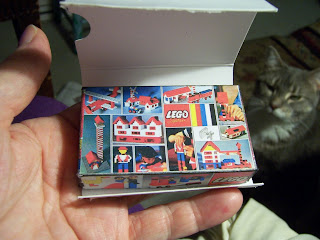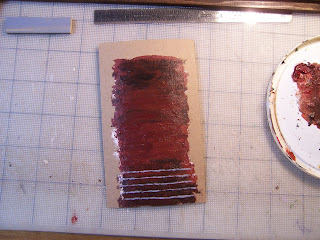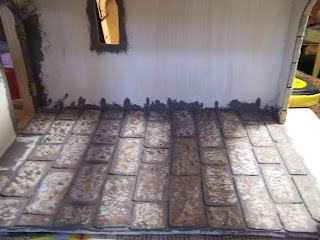Rabbeting Rails and Stiles....
I had a week of Vacation, Dear Readers, but you would not know it for the meager progress I made on the Dollmaker's Studio paneling. I had high hopes of completing at least one wall and maybe even adding the electrical fixtures... but there were many other RL tasks that slowed my progress. At least, I can blame it on that, but it probably was more to do with my uncertainty of the method to use for making this paneled wall! You can see in the above picture that I have cut a length of wood for the bottom "rail" of the paneling to fit along the length of the room. I had several unanswered questions about the technique to use to make the "rails"(horizontal pieces) and "stiles"(vertical pieces) of the paneling. Should I rabbet the edges of the rails and stiles so the panels were partly overlapped on each side and thus held securely in place? This would need thicker wood to begin with. Or should I use cardboard "spacers" between the panels and overlap the cardboard and panel edges with thinner strips that didn't require the rabbet on the edges? This would require thinner wood and several thicknesses of cardboard strips. And should I glue all the pieces to a mat board and then place it in the room.... or should I glue everything directly to the plywood wall....?
I started by turning the studio onto its side... or back,
so that I could work on the wall with gravity in my favor!
I took the bottom rail (1/8th inch by 1/2 inch stock)
and manually cut a "rabbet" (or rebate) along the under side edge.
This turned out to be easier to cut than I had feared.
Then I spaced the panels across the wall
to get a good idea of the precise measures.
The panels would space neatly with 1/8th inch between them
and 1/4 inch at each end. (This convenient spacing made life much easier!)
I added the next row of panels and tested
the spacing for the different widths of wood....
1/2 inch wide or 3/8th inch wide stock for the rails and stiles?
I preferred the look of the 3/8th inch stock
for both the rails and stiles.
And it would still allow enough overlap for
cutting the rabbets at 1/8th inch on each side.
This is just another view of the Studio on it's side....
Here is a view of the underside of the bottom rail...
showing my messy manual rabbet...
It is all cut with the exacto-knife.
I decided to make the manual rabbets in the thicker wood (1/8th inch stock)
in part because I think it will make the paneled wall
more structurally sound in the long run to use all wood.
(I could be wrong about this!)
I also decided I needed to build the paneling directly into the room.
This is mostly because the room dimensions are not perfectly square
and the plywood is a bit warped in places.
I didn't want to get it all built and then discover it
wouldn't quite fit past the edges of the opening
or the floor was too warped....
(remember the warped floor?)
And knowing how quickly small measuring discrepancies
can add up to a large error...
I decided to cut and fit each piece individually...
no mass cutting of pieces that turn out a fraction too short....!
I started by fitting the end stiles which are against the side walls.
Then made the stiles for every second pair of panels....
you will see the pattern as it develops.
It is hard to see the wood when it is blonde....
I am "staining" it with a watered down burnt sienna acrylic paint.
The paneling will not end up this color, so I don't need to match exactly.
The only piece that has been glued in place so far is the bottom rail!
This is the underside of the center stiles....
my cutting doesn't need to be exact, just needs to fit between the panels.
Here you can see it from the "side"
showing how it sits over the edges of the panels.
Once the taller stiles were all cut,
I could measure accurately for the rails that fit between them...
And then the short stiles between the rails...
All of this fiddling and dithering, Dear Readers,
took days and days!
And still nothing was glued in place but the bottom rail...
No, I did not glue those vertical stiles in the wrong places!
The not exact nature of the plywood walls
meant that the rails in the middle row
are a tiny bit longer than the bottom.
This is the advantage to building it the slow way!
It was at this point that I decided the bottom row of panels
and the rails and stiles needed to be glued down....
there was too much "shifting" happening...
and I needed to find out how well the glue part would work...!
So I took my courage in my hands
and started to apply the glue to each piece....
trying to position them exactly
and not get too much glue in the wrong places...
And then needed to find the right sized books to weight it all down!
(I had not thought that through!)
Then I let it dry.
The following day I was able to position the
remaining panels in their places (no glue yet!)
And I also discovered that
not all the glue was sticking properly.... grrrr...
I am using ordinary wood glue ...
because this is wood....
but the plywood has been primed
and I know this interferes with good adherence....
Sigh.
I am still deciding what to do.
One or two of the small stiles are not attached.
A couple of the ends of others are not Well attached....
There is a chance I will be picking it apart
and using different glue on some or all of it.
I am not looking at it for a couple of days...
It might not be as bad as I think it is....!
But that is as far as I got, Dear Readers,
On my Vacation paneling project,
Rabbeting rails and stiles.


























































